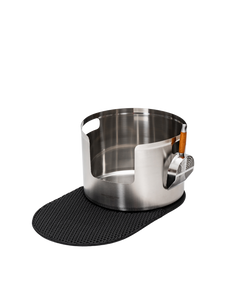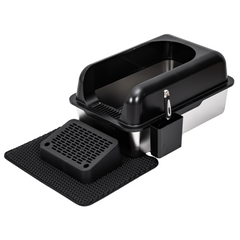Kittens are adorable bundles of energy, but they can also be vulnerable to various health issues, one of the most common being intestinal worms. Understanding the signs and symptoms of worms in kittens is crucial for their health and well-being. In this blog, we’ll explore how to identify if your kitten has worms, why an open top litter box is vital for monitoring their health, and recommend some of the best Australian worming products to keep your furry friend healthy.
How Do I Know If My Kitten Has Worms?
If you're wondering, "How do I know if my kitten has worms?" you're not alone. Worms are a common issue in kittens, and they can cause a variety of symptoms. Here are some signs to look out for:
-
Visible Worms: The most obvious sign is seeing worms in your kitten's stool, around their anus, or in their vomit. Common types of worms include roundworms, tapeworms, and hookworms, which may appear as small, white, or tan strands (Dantas-Torres & Otranto, 2014).
-
Potbelly: A bloated or potbellied appearance, especially in a kitten that is otherwise thin, can be a sign of worms. This is particularly common in kittens with a heavy load of roundworms (Traversa, 2012).
-
Diarrhea or Vomiting: Worms can cause gastrointestinal distress, leading to diarrhea or vomiting. Persistent symptoms should be taken seriously, as they can indicate a severe infestation or secondary infection (Nolan & Smith, 2010).
-
Weight Loss: Even if your kitten is eating normally, worms can absorb the nutrients, leading to weight loss. This nutrient depletion can also weaken the kitten’s immune system, making it more susceptible to other illnesses (Bowman, 2020).
-
Lethargy: A kitten with worms may be less active and more tired than usual due to the strain on their body. The energy demands of the parasite can drain the kitten’s vitality, leading to noticeable lethargy (Fisher, 2011).
If you notice any of these symptoms and are asking, "How do you know if your kitten has worms?" it’s important to take action. A visit to the vet is essential for diagnosis and treatment.
The Importance of an Open Top Litter Box
One of the most effective tools for monitoring your kitten’s health is their litter box. An open top litter box allows you to quickly and easily observe your kitten’s waste, which can provide critical clues about their health.
Visibility for Health Monitoring
An open top litter box gives you an unobstructed view of your kitten’s urine and faeces, making it easier to spot abnormalities. Worms, blood, mucus, or changes in stool consistency can all be signs of underlying health issues, such as:
-
Worm Infestations: As mentioned earlier, seeing worms in your kitten’s stool is one of the most direct indicators of an infestation. With an open top litter box, you can immediately spot any unusual signs and seek veterinary care.
-
Urinary Tract Issues: Changes in urination, such as straining, frequency, or blood in the urine, can indicate urinary tract infections (UTIs) or other issues. These symptoms are more easily noticed in an open top litter box where visibility is unobstructed (Buffington et al., 2019).
-
Digestive Problems: Diarrhea, constipation, or changes in stool color can be early indicators of digestive issues or dietary problems. Being able to monitor your kitten’s litter box habits closely can help you catch these problems early (Smith et al., 2017).
Encouraging Proper Use
Kittens are more likely to use a litter box that feels safe and comfortable. An open top litter box can reduce feelings of confinement, especially for a kitten adjusting to their new environment. This encourages proper litter box use, making it easier for you to monitor their health.
Easy Maintenance
Open top litter boxes are generally easier to clean and maintain. Regular cleaning is crucial to prevent the spread of parasites and bacteria. By keeping the box clean and monitoring its contents, you can create a healthier environment for your kitten.
How to Tell If Your Kitten Has Worms
To tell if your kitten has worms, a veterinarian can perform a faecal examination to detect the presence of worm eggs or adult worms. This is a simple and effective way to confirm an infestation and determine the type of worm.
-
Veterinary Diagnosis: Your vet will likely ask about your kitten's symptoms and perform a physical exam. They may also recommend a faecal test, which involves analysing a sample of your kitten's stool under a microscope.
-
Treatment Options: If your kitten is diagnosed with worms, the vet will prescribe an appropriate deworming medication. It's important to follow the treatment plan closely to ensure all worms are eliminated.
Recommended Australian Worming Products
There are several effective worming products available in Australia that can help keep your kitten free from worms. Here are a few trusted options:
-
Milbemax Allwormer Tablets for Cats: Milbemax is a broad-spectrum wormer that treats and controls roundworms, hookworms, and tapeworms. It's easy to administer and suitable for kittens.
-
Drontal Allwormer for Cats: Drontal is another popular choice that effectively treats and controls all common intestinal worms. It's available in tablet form and is safe for kittens from six weeks of age.
-
Revolution Plus for Cats: Revolution Plus is a topical treatment that not only controls intestinal worms but also provides protection against fleas, ticks, and heartworm. It’s a convenient option for comprehensive parasite protection.
-
Profender Allwormer for Cats: Profender is a topical solution that targets and treats all major gastrointestinal worms. It's an easy-to-use spot-on treatment that’s suitable for kittens.
Preventing Worms in Kittens
Preventing worms is easier than treating an infestation. Here are some tips:
-
Regular Deworming: Kittens should be dewormed every two weeks until they are 12 weeks old, and then monthly until they are six months old. After that, regular deworming every three months is recommended.
-
Clean Environment: Keep your kitten's living area clean and free of feces, which can harbor worm eggs. Regularly clean their litter box and avoid letting them roam in areas where they might ingest worms.
-
Flea Control: Fleas can carry tapeworms, so controlling fleas is another important step in preventing worms.
Conclusion
Understanding how to tell if your kitten has worms and knowing what to do about it is crucial for any cat parent. An open top litter box is an invaluable tool in this process, allowing you to monitor your kitten’s health closely and spot any potential issues early. Regular vet check-ups, preventative care, and a clean environment will help keep your kitten healthy and worm-free.
For more tips on kitten care and the best products to keep your home fresh and your kitten happy, check out Barely There Litter.
Remember, a healthy kitten is a happy kitten, and with the right care, you can ensure your new furry friend grows up strong and content.
References:
- Dantas-Torres, F., & Otranto, D. (2014). Veterinary Parasitology
- Traversa, D. (2012). Cat Parasitology in Veterinary Science
- Nolan, T. J., & Smith, G. (2010). Gastrointestinal Parasitology in Small Animals
- Bowman, D. D. (2020). The Impact of Helminth Infections on Animal Health
- Fisher, M. A. (2011). Clinical Parasitology in Veterinary Practice






